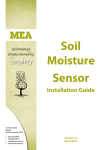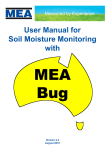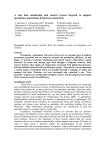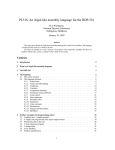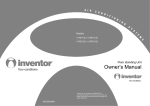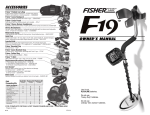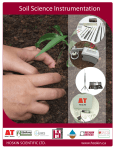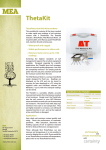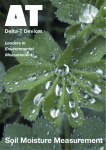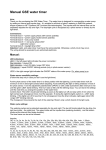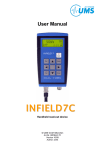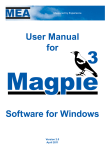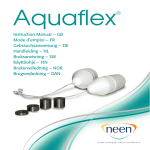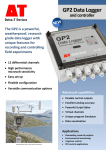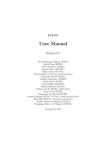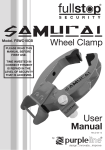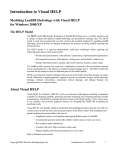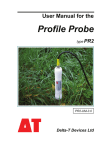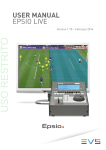Download Soil Moisture Sensors
Transcript
MEA soil moisture and climate monitoring with certainty Get a Green Brain Installation Guide for Soil Moisture Sensors 41 Vine Street Magill South Australia 5072 p f e w 08 8332 9044 08 8332 9577 [email protected] www.mea.com.au Version 6.0 August 2012 Soil Moisture Sensor Installation Guide Notices Copyright Copyright © Measurement Engineering Australia Pty. Ltd. 2012 All rights reserved. Under the copyright laws, this manual may not be copied, in whole or in part by any means without the written consent of Measurement Engineering Australia Pty. Ltd. Design Changes Measurement Engineering Australia Pty. Ltd. reserves the right to change the designs and specifications of its products at any time and without prior notice. Contact Measurement Engineering Australia Pty. Ltd. 41 Vine Street MAGILL SA 5072 Telephone 08 8332 9044 Fax: 08 8332 9577 Email: [email protected] Web: www.mea.com.au Warranty MEA offers a 12 month, return-to-factory warranty on all new logging systems and hardware. The warranty applies to hardware, software and system defects only. The warranty does not cover acts of misuse by the user or third parties, including misuse arising from failure to install or operate a system or its components in accordance with relevant system documentation, or failure to seek advice from MEA regarding correct installation or operation of a system or its components. Support If you have questions or problems that cannot be resolved using the information in this manual, contact MEA technical support using the details above. If phoning, ask for the Operations Manager and explain the issue. The Operations Manager will assign a Technician to help resolve the issue. Quoting your MEA Job Reference Number will enable us to quickly locate your details. Phone support is generally available Monday to Friday between 9am and 5pm Central (ie South Australian) Standard or Summer Time. Site visits can be arranged but will incur charges for labour, travel time and where applicable, accommodation and meals. MEA technicians can only offer support for issues relating directly to the operation of Magpie software or MEA logging systems or hardware. For general computer issues please consult a computer technician. www.mea.com.au Page 2 Soil Moisture Sensor Installation Guide Contents 1. Introduction.............................................................................. 5 2. General Considerations............................................................ 6 3. 4. 5. 6. 7. 2.1. Content vs Tension........................................................................ 6 2.2. ‘Spot’ vs ‘Continuous’ Monitoring................................................. 6 2.3. Number and Location of Monitoring Sites................................... 7 2.4. Sensor Depths............................................................................... 7 2.5. Make a Detailed Site Plan............................................................. 9 2.6. Protection of Loggers and Sensor Wiring. ................................... 9 Gypsum Blocks........................................................................11 3.1. About Gypsum Blocks. ............................................................... 11 3.2. Which Gypsum Block?. ............................................................... 12 3.3. Installing Gypsum Blocks............................................................ 12 ThetaProbes............................................................................ 17 4.1. About ThetaProbes..................................................................... 17 4.2. Installing ThetaProbes................................................................ 18 EnviroPro................................................................................ 20 5.1. About the EnviroPro. .................................................................. 20 5.2. Which Probe to Use. ................................................................... 20 5.3. Installing EnviroPros................................................................... 21 5.4. Preparation. ................................................................................ 21 5.5. Installation. ................................................................................. 21 FullStop Wetting Front Detectors........................................... 24 6.1. About FullStops. ......................................................................... 24 6.2. Installing FullStops...................................................................... 25 Aquaflex Soil Moisture Sensor................................................ 28 7.1. About Aquaflex Sensors. ............................................................ 28 www.mea.com.au Page 3 Soil Moisture Sensor Installation Guide 7.2. 8. 9. 10. 11. Installation of Aquaflex Sensors................................................. 29 Profile Probes......................................................................... 31 8.1. About Profile Probes................................................................... 31 8.2. Installing Profile Probes.............................................................. 32 W.E.T. Sensors......................................................................... 35 9.1. About W.E.T. Sensors................................................................... 35 9.2. Installing W.E.T. Sensors.............................................................. 35 Displays, Loggers & Software................................................. 36 10.1. GDot............................................................................................ 36 10.2. GDot Switch Box......................................................................... 36 10.3. MEA Retriever. ............................................................................ 36 10.4. GBug............................................................................................ 37 10.5. GTBug.......................................................................................... 37 10.6. TBug............................................................................................ 37 10.7. ABug............................................................................................ 38 10.8. MEA Bug Software...................................................................... 38 10.9. HH2 Reader................................................................................. 38 10.10. SML.............................................................................................. 39 10.11. MEA Radio................................................................................... 39 Wiring Guides......................................................................... 40 11.1. GBug Wiring Diagram................................................................. 40 11.2. GTBug Wiring Diagram............................................................... 40 11.3. ThetaProbe Wiring...................................................................... 41 11.4. AquaFlex Wiring.......................................................................... 41 11.5. GDot Switch Box Wiring.............................................................. 42 12. Safety...................................................................................... 43 13. Glossary.................................................................................. 44 www.mea.com.au Page 4 Soil Moisture Sensor Installation Guide 1. Introduction Irrigation without soil moisture monitoring can be costly, wasteful guesswork. However, poor placement or installation of soil moisture sensors will result in poor data that does not accurately represent soil moisture conditions. Sensors installed correctly in the right location will result in good data and can contribute to good irrigation outcomes. The purpose of this Guide is to help you install your soil moisture sensors in the right way, in the right place. This Sensor Installation Guide covers the placement and installation of the following: ●● Gypsum block soil moisture tension sensors ●● ThetaProbe soil moisture content sensor ●● EnviroPro soil moisture content, salinity and temperature probes. ●● FullStop Wetting Front Detectors ●● Aquaflex soil moisture content and temperature sensors ●● Profile Probe soil moisture content sensors ●● W.E.T. soil moisture content, electrical conductivity and temperature sensors www.mea.com.au Page 5 Soil Moisture Sensor Installation Guide 2. General Considerations Before purchasing and installing soil moisture monitoring systems, a number of things must be considered. 2.1. Content vs Tension The first decision to make is whether to measure soil moisture content or tension. These two parameters are opposite sides of the same coin. Soil Moisture Content Sensors (eg ThetaProbe, EnviroPro, Profile Probe) Soil moisture content sensors measure how much water is contained in the pore spaces of a given volume of soil, expressed either as a percentage (%vol) or a ratio (m3.m-3). This is also known as volumetric soil moisture measurement. This type of measurement can be easy to understand, as there is a direct relationship between the amount of water applied and the amount of water contained in the soil. Volumetric sensors take the irrigator’s point of view: “How much water do I have to apply to refill the profile?” Soil Moisture Tension Sensors (eg Gypsum Blocks) Soil moisture tension (also known as matric potential) sensors measure the energy required for roots to extract moisture against the capillary forces that hold it in the soil. The force required is measured in kiloPascals (kPa). Soil moisture tension sensors take the plant’s point of view: “How hard is the plant having to work to extract moisture from the soil?” 2.2. ‘Spot’ vs ‘Continuous’ Monitoring ‘Spot’ Monitoring Systems In ‘spot’ monitoring, soil moisture readings are taken one at a time with a hand-held Reader. In some instances the Reader is able to store the readings in memory for later retrieval. In order to obtain detailed data the user must perform many measurements as the only moisture value available is the one present at the time the sensor is read. The relatively low costs of ‘spot’ monitoring will allow for a greater number of monitoring sites, but monitoring resolution and the ability to analyse trends in water use will be limited by the time available to perform measurements. ‘Continuous’ Monitoring Systems In ‘continuous’ monitoring systems, a data recorder reads a sensor or number of sensors at set intervals and stores the values in memory for later retrieval. Sensors are read frequently and automatically, and some cases the ‘read interval’ is programmable. Data can be retrieved with a ‘shuttle’ storage device such as an MEA Retriever, by connecting a PC to the Logger with a cable, or transferred to the Internet. Retrieved data is downloaded to a computer and can be viewed as tables or graphs, allowing analysis of www.mea.com.au Page 6 Soil Moisture Sensor Installation Guide water use and soil moisture trends over time. Changes in soil moisture and other values such as rainfall can be easily and accurately monitored, and the grower’s time is freed to perform other tasks. 2.3. Number and Location of Monitoring Sites Some ‘rules of thumb’ can be applied when considering the number and location of sites: ●● One site per irrigation shift, OR ●● One site per plant variety, OR ●● One site per soil type ●● Find an ‘average’ plant away from the edges of the crop ●● Ensure that the dripper or sprinkler works and the flow-rate is correct ●● Check that there is no surface runoff due to slopes, mounding or terracing, and that water does not pool at the intended installation site ●● Place sensors in the wetted pattern after first irrigating on dry soil to show where the water goes Start with the minimum number of sites required to provide the information needed to manage the property. Observations made over time will allow you to determine if more or fewer monitoring sites are required. 2.4. Sensor Depths Enough sensors should be installed to give a representative picture of what is happening through the root zone and to match the soil profile. If there are discrete soil layers in the profile, each should be monitored. In most cases monitoring at 3 or 4 depths is adequate. If there is a hard pan or impervious layer, a sensor should be placed just above it, to detect the presence of a perched water table. If gypsum blocks are used, use GBLites for sand or loam layers, and GBHeavies for clay-heavy soils (a mix of sensors with the one logger is OK) In vines and citrus, 3 sensors are usually placed in the root zone, with an extra sensor just below the root zone to detect drainage. In annual and shallow rooted crops, 1 or 2 sensors in the root zone and another for drainage is sufficient. www.mea.com.au Page 7 Soil Moisture Sensor Installation Guide Many sources cite typical root zone depths for annual and permanent crops, for example 1 m for vines. The plant root zone can differ from this considerably (and vary between sites as well). A layer of clay, rock or sodic soils can limit the root zone to much less than this; in a friable or gravely soil, the roots can penetrate much deeper. The only way to know for certain is to excavate a soil pit or take core samples. Once rainfall has been depleted in the soil profile, the only active roots feeding the plant are within the wetted zone of the irrigation dripper or sprinkler. Sensors must be placed in this zone, where they will measure the ‘water of last resort’. Typical % Water Typical % Root Zone Top sensor detects rainfall and shallow irrigations 40% 30% 20% 10% Transpiration Fig. 1. www.mea.com.au 25% Active root-zone sensor. Most useful for irrigation decisions Sensor Drainage sensor 25% 25% 25% Drainage The relationship between root depth and water use. The plants will draw water firstly from the upper levels, with deeper water being sought out once the upper levels dry out. Page 8 Soil Moisture Sensor Installation Guide 2.5. Make a Detailed Site Plan Sensor installation will be easier if a detailed site plan is prepared prior to installation. Include the name of each measurement site (eg. Shiraz, Merlot etc.), the depths or positions at which the sensors are to be installed (eg. 20cm, 50cm etc.), the type of Logger if a mix of types is used, and the type of sensor (eg. GBLite, GBHeavy, temperature, Aquaflex) installed at each location. 2.6. Protection of Loggers and Sensor Wiring Protect loggers and any exposed sensor wiring from damage by animals or machinery. This is best implemented at the time of installation. Sensor wiring can be protected by enclosing it in electrical conduit or polypipe, or by burying it. Sensor cables can be extended in order to obtain more distance between the sensors and logger so that the logger can be placed in a secure location. Loggers can be mounted to a convenient strainer post or to a hardwood stake, or installed inside galvanised channel as per the photograph at right: ●● The height of the post should be set to match the type of machinery or plant being used at the site ●● If installing in vineyards, set the top of the post below the height of the fish plates on the harvester ●● If installing in crops irrigated using a centre pivot or lateral move system, ensure that the top of the post is lower than the irrigator boom Fig. 2. An MEA GBug installed inside ‘C-channel’ for protection from machinery. Sensor wiring is enclosed in 32mm conduit. ●● In tall crops, a bicycle flag can be fitted to the top of the stake to help locate the site, or a mark made on an end-post to alert machinery operators to the presence of the logger www.mea.com.au Page 9 Soil Moisture Sensor Installation Guide Protection is also about finding the right location for the equipment. In vineyards for example, loggers or radios should be installed ‘inside’ the vine row where they will be out of the way of machinery or workers (the sensors themselves should be located as per the advice given later in this publication). Ensure that the logger enclosure is not being sprayed directly by sprinkler systems. Fig. 3. www.mea.com.au A GBug soil moisture logger installed ‘out of the way’ in a vine row. Page 10 Soil Moisture Sensor Installation Guide 3. Gypsum Blocks Fig. 4. 3.1. GBHeavy and GBLite About Gypsum Blocks Gypsum blocks are a type of soil moisture tension sensor, and use the same readout units as the industry standard tensiometer - kilo pascals (kPa). Gypsum blocks are one of the lowest cost soil moisture monitoring products available. A block of porous gypsum placed in the soil will wet up and dry out in a similar manner to the soil itself. A gypsum block in wet soil conducts electricity easily, and poorly in a dry soil. A pair of electrodes within the block measure this change and a standard calibration equates the resistance of the block to soil moisture tension. Gypsum blocks can be used with: ●● MEA’s GBug or GTBug loggers in conjunction with an MEA Retriever and MEA Bug software for continuous soil moisture monitoring ●● MEA’s GBReader or GDot (with optional GB Terminal) for ‘spot’ monitoring ●● MEA Radio systems for continuous monitoring over a wide area See “10. Displays, Loggers & Software” on page 36 for more information. www.mea.com.au Page 11 Soil Moisture Sensor Installation Guide 3.2. Which Gypsum Block? MEA’s GBHeavy (MEA2176) is best suited to a tension range of 50 to 500 kPa (the range found in heavy soils having a high clay content). The GBLite (MEA2195) is calibrated over a tension range of 10 to 200 kPa (sand to sandy clay loam). The choice of which type of block to use is simple: if moisture levels are to be kept in the range where it is readily available to the plants, use the GBLite regardless of soil type. Where the crop is going to be pushed into deficit, (e.g. with Partial Root Zone Drying and Regulated Deficit Irrigation), use the GBHeavy in soils with a substantial clay content and the GBLite in sandy soils. The GBHeavy sensor also makes a cost efficient drainage detection sensor when used below a set of GBLites. 3.3. Installing Gypsum Blocks 3.3.1. What You Will Need ●● 25mm Auger (MEA2193) ●● Masking tape or electrical tape ●● 13mm (½”) PVC pressure pipe, 1.2m in length ●● Trowel ●● Bucket & water ●● Active Gel Bentonite (MEA2197, 2kg pack will cover 15 - 20 sensors) ●● Dry builder’s sand ●● 12mm dowel, 1.2m length ●● Tape measure, notebook, tags & permanent marker ●● GBReader or Bug and Retriever to test blocks www.mea.com.au Page 12 Soil Moisture Sensor Installation Guide 3.3.2. Where to Place the Blocks Drip Irrigation Install the sensors at four different depths, equally spaced on the circumference of a 10 ~15 cm radius centred directly under the dripper. Mark the locations to make it easier to auger the holes. Install each sensor in its own hole - stacking the blocks vertically can lead to leakage down the hole, and makes it difficult to replace individual sensors if later required. Pre-marked installation site for each block. Circle of 10 ~ 15 cm radius centred under dripper. Fig. 5. Holes marked under a dripper prior to augering. Sprinklers Install the sensors in a straight line 10cm apart, in a location where the sprinklers are delivering their rated output. 3.3.3. Getting the Blocks in the Ground ●● Mark the Auger with tape at the installation depths, and auger holes for the sensors one at a time ●● Keep the soil removed, you will need it to help correctly seal the sensors ●● Pour half a cup of water down the holes to ensure correct seating of the sensors ●● Unwrap the foil from the GBHeavy blocks or unpack the GBLites from their plastic bags. Do not touch the sensors as the oils in your skin can block the surface pores of the blocks ●● Soak the sensors in a bucket of clean water for around 15 minutes ●● While the sensors are soaking, mark up the 1/2-inch PVC pressure pipe with the installation depths (don’t forget to allow for half the sensor length) www.mea.com.au Fig. 6. Augering holes with an Auger pre-marked with the installation depths. Page 13 Soil Moisture Sensor Installation Guide ●● Push the cable from the sensor up through the pipe ●● Hold the cable taut and use the pipe to gently push the sensor into the hole ●● Use the marks on the pipe to ensure the sensor is at the intended depth ●● Withdraw the pipe ●● Pour a handful of earth down the hole and gently compact with the dowel ●● Mix 1 part Active Gel Bentonite with 4 parts fine dry sand and backfill the hole to around 25 mm from the top ●● Use more earth to complete filling the hole. Do not overfill as this will form a surface cap which will shed water away from the sensor ●● Use the permanent marker to label the sensor wire with the depth, installation date and sensor number (a cattle tag is useful for this) Fig. 7. Using PVC pipe to insert the sensors. ●● Connect the sensor to the Bug or GB Terminal using the supplied wiring diagram and low voltage irrigation connectors - see “3.3.5. Using Low Voltage Irrigation Connectors” on page 16 ●● Once all sensors are connected, confirm the connections are good by taking a reading - it should show ‘wet’ since the sensor was saturated just prior to installation Installing GBLites in Shallow Root Zones In many vegetable crops, the root zone can be very shallow – under 20 cm. The active feeder roots of citrus, particularly when grown in sandy soils can also be quite shallow. The GBLite sensors can be installed at shallow depths by simply laying the sensor horizontally in the soil in a hole opened up with a spade or trowel (in place of the gypsum block auger). Install using Silica Flour (see “3.3.4. Improving the Sensor-to-Soil Contact” on page 15). In very sandy soils, this technique can also improve water flow into and out of the sensor. GTBug Temperature Sensor The temperature sensor should be installed between 100 mm and 150 mm where daily fluctuations in surface temperature are minimised. This sensor can simply be placed in a hole of the correct depth and backfilled, gently compacting the soil as you go. www.mea.com.au Page 14 Soil Moisture Sensor Installation Guide 3.3.4. Improving the Sensor-to-Soil Contact In reactive clay soils and in light sands, the installation procedure can be modified to improve soil to sensor contact. This avoids problems with clay soils shrinking away from the sensors or with sandy soils drying down faster than the sensor can respond. The change involves bedding the sensors in a slurry of intermediate material. Three types of slurry may be used: ●● Clay loam: mix a slurry using clay loam found elsewhere on site ●● Silica flour: make a slurry using 300 or 400 grade silica flour (MEA2198, 1 kg pack). Feedback from MEA field agents indicates that in sandy soils, sensor to soil contact for GBLites can be improved by simply dipping the saturated sensor into dry Silica flour ●● Silica flour and diatomaceous earth: make a 50/50 slurry of these two materials Fill a jar to 90% capacity with the chosen material; top up with water, put on the lid and shake until mixed. A small quantity of the slurry can be poured into each hole or else the sensor can be dipped into a jar of the slurry to coat it prior to installation - only a thin coat is required. The GTBug temperature sensor does not require this treatment. Silica flour can cause serious lung disease and irritation to the eyes and respiratory system. Please comply with the precautions advised in the Material Safety Data Sheet supplied with the Silica flour www.mea.com.au Page 15 Soil Moisture Sensor Installation Guide 3.3.5. Using Low Voltage Irrigation Connectors Wire from Bug Wire from sensor Low voltage irrigation connectors are supplied for connecting gypsum blocks to GBugs, GTBugs or GBSwitches. If you have not used these connectors previously, the following notes will be of use: ●● Use one connector per join (two per gypsum block). The connectors have three holes - use one for a sensor wire, and one for a Bug wire - leave the third hole unused ●● Don’t strip the insulation from the wires to be joined. The metal plates inside the connectors work by displacing the insulation, and stripping it back can result in a poor connection. ●● GBLite sensor wires are sometimes terminated with a small ring connector - this will have to be cut off before insertion into the irrigation connector ●● Push one wire from the gypsum block and the relevant coloured wire from the Bug into the connector as far as they will go. The connectors are translucent on the opposite side of the black button so you will be able to see when the wires are all the way in ●● Holding the wires in place, use pliers or multi-grips to push the black button on the connector all the way down ●● Repeat for all remaining connections ●● After all the blocks are connected, ensure that the end of the Bug cable is off the ground and pointing downward so that water is not able to collect in the cable. For added protection you can wrap the end of the cable in waterproof tape www.mea.com.au Page 16 Soil Moisture Sensor Installation Guide 4. ThetaProbes 4.1. About ThetaProbes ThetaProbes are a type of volumetric soil moisture content sensor. The probe consists of a waterproof housing containing electronics with an array of stainless steel electrodes at one end (for direct insertion into undisturbed soil) and a power/signal cable at the other. Fig. 8. ThetaProbe The ThetaProbe measures soil moisture content with an accuracy of ± 1% over the range of 0 to 60% of volumetric soil moisture content. This level of accuracy makes the probe suitable for use where soil moisture levels are to be tightly controlled, and in critical applications such as hydrology, soil stability studies, soil water profiling, pollution monitoring, water leakage detection from pipes and dams, ground-truthing and forestry. ThetaProbes can be used with: ●● TBug, MEA Retriever and MEA Bug software ●● MEA Radio system to provide continuous soil moisture monitoring ●● HH2 Reader to provide ‘spot’ measurements that can be downloaded to a PC See “10. Displays, Loggers & Software” on page 36 for more information. www.mea.com.au Page 17 Soil Moisture Sensor Installation Guide 4.2. Installing ThetaProbes 4.2.1. What You Will Need Surface Installation ●● Reader or TBug and Retriever Buried Installation ●● Spade or trowel for shallow installation, 40mm Auger (MEA2192) for deeper installation ●● Masking tape or similar ●● 32mm (1¼”) pressure pipe or similar, 300mm longer than the deepest installation depth ●● Active Gel Bentonite (MEA2197) ●● Dry builder’s sand - 4 times the quantity of bentonite ●● 12 mm dowel, length as above ●● Tape measure, notebook, tags & permanent marker ●● Reader or TBug and Retriever 4.2.2. Getting the Probes in the Ground Surface Installation ●● For surface installation the stainless steel rods can just be pushed into undisturbed soil ●● If the probe is going to be left in place, it is a good idea to insert it at a slight angle (eg 10°~20°) so that water running down the outside of the probe is less likely to pool around the electrodes - make sure the electrodes are completely covered ●● Try to ensure there are no air pockets or stones around the electrodes as this will reduce the quality of the measurements ●● Take care not to bend the rods ●● Use your Reader or TBug-and-Retriever to take a reading to verify operation of the probe(s) Buried Installation The need to monitor a particular part of the root zone can require a buried installation. Even with a shallow installation, it might be preferable to bury the probe to provide protection for it. ThetaProbes can be installed either horizontally or vertically depending on the depth of installation and installation equipment available. www.mea.com.au Page 18 Soil Moisture Sensor Installation Guide Installing a ThetaProbe Horizontally The probes may be installed horizontally in shallow sites. The sensor should be inserted into undisturbed soil on the face of the trench: ●● At the monitoring site, excavate a trench down to 10 cm below the sensor depth. Clean off the face of the hole at the required depth ●● Push the rods into the side of the hole until the soil comes in contact with the probe body ●● Route the sensor cable out of the hole to the surface (it can be sheathed in conduit to protect it against damage) ●● Carefully backfill under and around the sensor Installing a ThetaProbe Vertically ●● Use the masking tape to mark the Auger with the installation depth(s) ●● Auger the hole. As with surface installation, it is a good idea to auger the hole on a slight angle (eg 10°~20°) to prevent water collecting at the rods ●● Thread the probe cable and connector (if fitted) through the pressure pipe and use this to push the sensor down the hole, pushing the rods into the undisturbed earth at the bottom of the hole. Take care not to bend the rods ●● Withdraw the pipe ●● Pour a handful of earth down the hole and gently compact with the dowel ●● Mix 1 part Active Gel Bentonite with 4 parts fine dry sand and backfill the hole to around 25 mm from the top; use the dowel to gently compact as you go ●● Use more earth to complete filling the hole. Do not overfill as this will form a surface cap which will shed water away from the sensor ●● Connect the probe to the TBug or other Reader and take a reading www.mea.com.au Page 19 Soil Moisture Sensor Installation Guide 5. EnviroPro 5.1. About the EnviroPro EnviroPro probes provide reliable soil moisture, salinity and temperature measurement in all soil types. Multiple sensor clusters per probe at 100 mm spacings allow the monitoring of moisture, salinity and temperature at each sensor depth. Soil moisture readings are temperature-compensated and can be salinity-compensated. The internal electronics are fully protected, making the probes reliable, consistent and very stable. Each probe is supplied with 5 m of cable. Designed to be completely buried, the EnviroPro is ‘out of the way’ when slashing, spraying and harvesting. Moisture profiling at 100mm intervals allow you Fig. 9. EPSM4. to track the movement of water through the root zone and optimise irrigation events. Following the movement of nutrients through the root zone by tracking changes in salinity allows you to optimise fertiliser applications and only apply leaching irrigations when needed. EnviroPros can be used with: ●● MEA SML ●● MEA Radio See “10. Displays, Loggers & Software” on page 36 for more information. 5.2. Which Probe to Use The choice of probe to use will be determined by the size of the root zone or profile height to be monitored. The EPSM4 has 4 sensor clusters and is 500 mm long. The EPSM8 has 8 sensor clusters and is 900 mm long. The EPSM12 is 1300 mm long. The EPSM16 is 1700 mm long. www.mea.com.au Page 20 Soil Moisture Sensor Installation Guide 5.3. Installing EnviroPros 5.4. Preparation The EnviroPro should be installed using a fine sand and bentonite slurry to ensure there are no air gaps between the probe and the surrounding soil. The quantities and method described below will make a sufficient quantity of slurry for the installation of 2 EP100C-08 or EP100CL-08 probes, which are 80cm long. 5.4.1. Materials and Equipment Required ●● 1kg of fine sand (eg unimin AFS85 grade). ●● 100gm Bentonite (civil grade eg Unimin Active Gel 150). ●● 1L clean water. ●● Small bucket with lid. ●● Funnel. ●● 2L plastic bottle with lid. 5.4.2. Method 1. Mix the dry bentonite and sand together in a bucket. 2. Pour the dry mix through the funnel into the 2L plastic bottle. 3. Pour the water into the bottle, put the lid on and shake until thoroughly mixed. The slurry is ready for use after 15 minutes. 4. Always shake the mixture before application (the sand might settle in storage). 5.5. Installation 5.5.1. Tools Required ●● 36 - 38mm Auger. ●● Tape measure and adhesive tape.Where to Place an EnviroPro Drip Irrigation Similarly to Gypsum blocks, an EnviroPro should be placed somewhere within a 10 to 15 cm radius of the dripper, but not directly beneath the dripper. Sprinkler Irrigation Place an EnviroPro where the sprinkler is delivering its rated output. In tree crops and / or where overhead sprinklers are used, locate the EnviroPro at the drip-line of the tree. www.mea.com.au Page 21 Soil Moisture Sensor Installation Guide 5.5.2. Getting the Probe in the Ground ●● Use the tape measure and the adhesive tape to mark the auger 10 cm longer than the probe to be installed. ●● Auger a hole 10 cm deeper than the probe to be installed. Use the tape measure to check the depth after the auger is extracted to ensure that part of the hole wall has not collapsed or that other material has not fallen into the hole. ●● Pour slurry into the hole until it is 50% full. ●● Push the probe into the hole until the top is 25 mm below the soil surface. Apply a maximum of 15 kg of force to the probe. Avoid causing sharp bends in the cable where it enters the probe. ●● The slurry should ooze up around the instrument and slightly overflow the hole. If you do not see any slurry, carefully extract the instrument, mix up some more slurry and add to the hole ●● Backfill to cover the probe ●● Trench the cable in to a depth of 100 mm or deeper to protect it. Fig. 10. Mark the Auger at the required installation depth. www.mea.com.au Fig. 11. Dig the hole using a 36mm Auger. Page 22 Soil Moisture Sensor Installation Guide Fig. 12. Add the slurry to the hole. Fig. 13. Push the probe into the hole. The slurry should ooze up as the instrument is inserted. ●● Connect the EnviroPro to your reader or logger and wait for a reading to ensure the probe is operational. Readings should be at least slightly wet until the water content in the slurry and surrounding soil have equalised. www.mea.com.au Page 23 Soil Moisture Sensor Installation Guide 6. FullStop Wetting Front Detectors 6.1. About FullStops The FullStop provides a cost effective method of assessing whether too much or too little irrigation is being applied, to detect water logging and to monitor nutrient and salt levels in the soil. The heart of the FullStop is a funnel shaped collector which is buried in the soil. As moisture moves through the soil profile (a wetting front), it converges in the funnel and collects in a reservoir in the base of the unit. An indicator flag is fitted to an extension tube which protrudes above ground. When water collects in the base of the funnel, floats within the extension tube cause the indicator flag to pop up to show that the wetting front has arrived. The indicator flag is held Fig. 14. A FullStop Wetting up with a magnetic latch and must be pushed down Front Detector to reset it. If the soil is still very wet, the flag will pop up again. An outlet tube at the base of the FullStop allows water collected in the funnel to be extracted using a syringe, and tested for EC and nitrate levels. Unlike the other sensors in this guide, the FullStop requires no power source, Readers, Loggers or software. www.mea.com.au Page 24 Soil Moisture Sensor Installation Guide 6.2. Installing FullStops 6.2.1. What You Will Need ●● 20 cm and 5 - 10 cm Augers (or shovel and trowel if you don’t have access to the Augers) ●● Tape measure ●● Portable EC Meter (MEA2272) for monitoring salinity levels ●● Nitrate and nitrite test strips (MEA2273 and MEA2274) for monitoring nutrient levels 6.2.2. Where to Place the FullStops FullStops are sold and generally used in pairs, with one unit at one third of the root depth, and the second at two thirds of the root depth. Drip Irrigation ●● The detector must always be placed directly under a dripper. Suggested depth for the shallow detector is 30 cm and for the deep detector is 60 cm ●● Deeper placement is required for widely spaced drippers or long irrigation intervals. Shallower placement suits closely spaced drippers, frequent irrigation or shallow rooted crops ●● It is common for detectors to respond quickly under drip because all the water is being concentrated around the dripper, with dry soil between drippers. In such cases less water should be applied more often www.mea.com.au Page 25 Soil Moisture Sensor Installation Guide Sprinkler or Microjet Irrigation ●● Wetting patterns tend to be shallower under sprinkler irrigation than drip or furrow irrigation ●● Suggested depth for the shallow detector is 20 cm and for the deep detector is 40 cm. Note that it usually takes 20 mm or more of irrigation to activate a detector at 20 cm (depending on soil type and on how dry the soil is before irrigation) ●● For sprinkler systems that apply small amounts of water each day or second day (e.g. microjets or centre pivot), depths of 15 cm and 30 cm are more suitable (5 cm and 20 cm to the rim of the funnel). Detectors will usually not be activated by applications under 15 mm, unless the soil is quite wet before irrigation Furrow Irrigation ●● Detectors should be positioned half under the furrow and half under the bed with the extension tube rising through the shoulder of the bed ●● Suggested depth for the shallow detector is 20 ~ 30 cm and for the deep detector is 40 ~ 60 cm (from the base of the furrow). Deep rooted crops with less frequent irrigation would require deeper placement www.mea.com.au Page 26 Soil Moisture Sensor Installation Guide 6.2.3. Getting the FullStops in the Ground Following are instructions for installing the FullStops using Augers. A shovel can be used in place of the large Auger, and a trowel can be used in place of the small Auger. ●● Assemble and test the FullStops according to the instructions that came with them. Check for leaks, and make sure the float indicator can move freely through the extension tube(s). Attach as many extension tubes as required for the installation depth ●● Make a hole with the large Auger. This will accommodate the wide part of the funnel ●● When the hole is deep enough, use the small Auger to make a hole for the bottom of the FullStop ●● If the soil texture changes with depth, keep the different soil layers separate ●● Add the filter sand (supplied with the FullStops) to the detector until it covers the locking ring by at least 1 cm ●● Place the detector in the hole and measure the distance to the rim of the funnel to check that it reaches the required depth ●● Make sure the extension tubes are vertical ●● Fill the funnel with soil from the same layer, and lightly firm it down ●● Break up the sides of the hole before returning more soil, as smooth sides can restrict the growth of roots and the movement of water ●● Pack soil around the sides and under the funnel to keep it firmly in place (hold the outlet tube out of the way) - the deeper narrow hole does not need to be packed with soil ●● Return the rest of the soil to the hole in the layer order in which it was extracted ●● Soil should be firmed down by hand, but not compacted ●● Use the trowel to break up the top edge of the hole ●● All the soil should be returned to the soil, leaving a slight ‘hump’ which should settle after rain or irrigation. After settling, check that the soil is level so that water does not run away from or toward the detector ●● Push the tubing stake (supplied with the FullStop) into the end of the outlet tube (this will prevent insects and soil from entering and blocking the tube) and use it to position the tube away from the detector For more information please visit www.fullstop.com.au www.mea.com.au Page 27 Soil Moisture Sensor Installation Guide 7. Aquaflex Soil Moisture Sensor Fig. 15. An Aquaflex Soil Moisture Sensor (Model SI.99) - with the 3m sensor tape rolled up. 7.1. About Aquaflex Sensors The Aquaflex is a type of soil moisture content sensor. The sensor consists of a yellow waterproof housing containing electronics, and a 3 m ribbon cable (the sensor) which is installed on its edge. The Aquaflex averages soil moisture over its sensor length which results in a sampling volume of 6 litres of soil. It measures soil moisture content over the range of 0 to 60% with an accuracy of ±2%, and soil temperature over the range of -10° to 50°C. The Aquaflex is suitable for use in hydrology, soil stability studies, soil water profiling, pollution monitoring, water leakage detection from pipes and dams, ground-truthing and forestry. The major use of the Aquaflex sensor is to manage irrigation practices in shallow-rooted crops such as turf, sports grounds, parklands, golf courses, pasture applications and in horticulture - especially vegetable crops The Aquaflex is capable of 2 different types of output: ●● Frequency (for connection to pulse inputs devices such as flow meters). This output delivers soil moisture only ●● 4 to 20 mA current loop. Two separate outputs for soil moisture and temperature The Aquaflex can be used with: ●● ABug, MEA Retriever and MEA Bug software for continuous soil moisture and temperature monitoring See “10. Displays, Loggers & Software” on page 36 for more information. www.mea.com.au Page 28 Soil Moisture Sensor Installation Guide 7.2. Installation of Aquaflex Sensors 7.2.1. What You Will Need ●● String line to mark position of slit or trench ●● Turf cutter or spade for shallow installation, shovel for trenching for deeper installations ●● Water to ‘bed-in’ the sensor after backfilling ●● ABug and Retriever or Handheld Reader 7.2.2. Where to Place the Aquaflex Shallow-roooted Crops (eg Turf or Pasture Grasses) ●● Install the sensor sloping downward through the profile from around 50 mm below the surface to around 400 mm ●● A second Aquaflex can be installed at around 500 mm as a ‘check’ sensor to help identify over-watering Fig. 16. An Aquaflex installation under pasture www.mea.com.au Page 29 Soil Moisture Sensor Installation Guide 7.2.3. Getting the Aquaflex in the Ground Shallow Installations (eg Turf) ●● Select and mark the position of the sensor with a string line. Position the sensor where it can be easily located in future – e.g. on a marker line on a sports field ●● With a turf cutter or sharp, flat blade, carefully cut a slit in the turf ●● Carefully insert the sensor into the slit to the desired depth Fig. 17. Installing an Aquaflex in turf. ●● For the electronics block at the end of the sensor, carefully peel back sufficient turf to create a slightly larger and deeper cavity in which to bury the block - ‘wedge’ side up, and fold the turf back into position ●● Gently push from behind each side of the sensor slit to close it. Pack from the sides to recreate original density and remove air pockets ●● Repair and smooth as necessary ●● Apply a liberal amount of irrigation/water to allow the sensor to bed in and remove air pockets ●● Run the data cable in a slit or trench to the desired location ●● Take a reading with the Handheld reader or ABug and Retriever Hint: It is essential that the sensor cable be installed on its edge to prevent water pooling on the cable, which will give false moisture readings. Ensure the sensor is installed deep enough to avoid damage during site maintenance. After installation, allow time for the disturbed soil to settle before using the data from your Aquaflex Sensors. This can take some time depending on the soil conditions. The settling process can be accelerated by applying several heavy irrigations, ideally taking the soil to saturation each time. www.mea.com.au Page 30 Soil Moisture Sensor Installation Guide 8. Profile Probes 8.1. About Profile Probes A Profile Probe is a type of soil moisture content sensor, configured to measure moisture content at a number of different levels, providing a Soil Moisture Profile. Users can choose between: ●● the PR2/4, measuring at 4 depths: 10, 20, 30 & 40 cm, or ●● the PR2/6 measuring at 6 depths: 10, 20, 30, 40, 60 & 100 cm. The probes have low sensitivity to salinity and temperature. Connectors are sealed to IP68 (submersible). Extension cables are available. A Profile probe can be used with: ●● HH2 Reader for ‘spot’ measurements ●● a Data Logger for continuous soil moisture monitoring See “10. Displays, Loggers & Software” on page 36 for more information. Fig. 18. PR2/6 Profile Probe www.mea.com.au Page 31 Soil Moisture Sensor Installation Guide 8.2. Installing Profile Probes 8.2.1. What You Will Need Profile Probes are installed using closed-bottom access tubes of a length suitable to the type of probe in use. In short, a 27 mm hole is augered, the tube is driven into the hole, and the PR2 probe is inserted into the access tube to take readings. Optimal contact between the soil and the access tube is essential, and the use of a purpose-designed Augering Kit is recommended. An augering kit may be available for loan or purchase from MEA. The most comprehensive augering kit, PR-ACK1, consists of: ●● A Stabilisation Plate (to keep the augered hole vertical, and to help prevent ‘funnelling’ of the hole while it is being augered) and centring bushes ●● Pilot and Finishing Augers for ‘standard’ installation ●● An Insertion Rod for driving the access tube into the augered hole ●● Dead-blow mallet to use with the Insertion Rod ●● Access tube(s) ●● A cleaning rod for cleaning the inside of the Access Tubes ●● A set of ‘flexicanes’ for marking the location of Access Tubes ●● A carry bag for all of the above In addition to the equipment contained in the Augering Kit, the following items are useful: ●● Mist sprayer to help lubricate Augers ●● Stiff brush and cleaning cloths to help clean Augers ●● Bucket ●● Access Tube caps or bungs (where the Access Tube will be left on site) www.mea.com.au Page 32 Soil Moisture Sensor Installation Guide 8.2.2. Getting a Profile Probe in the Ground A 25-page Profile Probe Augering Manual is available which covers installation in various soil types in detail, and users of Profile Probes are encouraged to refer to it. The following procedure covers a ‘standard’ installation in ‘normal’ soil: Pilot Auger ●● Choose a patch of ground that is as level and free of stones as possible ●● Assemble and secure the Stabilisation Plate and fit the white centring bush ●● Push the Pilot Auger through the centring bush by approx. 100 mm ●● Ensure the top of the Auger does not wobble Fig. 19. Stabilisation Plate with white centring bush fitted ●● Use a mist-sprayer or similar to lubricate the outside of the auger with water during augering. Rotate the Auger as you withdraw it. It also helps to rotate the Auger every few centimetres during insertion, to help keep it on a straight path ●● Clean the extracted soil from the Auger ●● Repeat the process until the hole is deep enough Finishing Auger ●● Fit the blue centring bush to the Stabilisation Plate ●● Insert the Finishing Auger through the centring bush and rotate clockwise, applying a lubricating mist of water all the time ●● Aim to auger 100 ~ 200 mm at a time ●● Retract the Auger while rotating it anticlockwise ●● Clean the extracted soil from the auger ●● Repeat the process until the hole is deep enough www.mea.com.au Fig. 20. Finishing Auger inserted through the blue centring bush Page 33 Soil Moisture Sensor Installation Guide Inserting the Access Tube ●● Check that the augered hole is deep enough ●● Fit the yellow centring bush to the Stabilisation Plate ●● Start pushing the Access Tube into the hole using the Insertion Rod ●● If you meet sufficient resistance, you will need to use the mallet. Hold the Access Tube steady to prevent wobbling ●● Continue until the top of the Access Tube is level with the top of the centring bush ●● Leave the Insertion Rod in place to prevent material falling down the Access Tube, and remove the Stabilisation Plate ●● Remove the Insertion Rod Completing the Installation ●● If necessary, clean the inside of the Access Tube before inserting the Profile Probe Fig. 21. Inserting the Access Tube ●● Insert the Probe and take 3 readings, rotating the Probe through 120° increments. Unexpectedly low readings could indicate the presence of air gaps or stones, and the user will need to consider re-installation ●● If the Access Tube is to be left in position, fit a Black cap (where the top of the Tube is above ground level), or a Red bung (if the top of the Tube is at ground level) www.mea.com.au Page 34 Soil Moisture Sensor Installation Guide 9. W.E.T. Sensors 9.1. About W.E.T. Sensors The WET Sensor is a multi-parameter sensor for use in soils, composts and other artificial growing media. It measures Water content, Electrical conductivity, and Temperature. In five seconds the probe can provide a measure of water content over the range of 0 to 80%, pore-water conductivity from 0 to 600 mS.m-1, and temperature over the range of 0 to 40°C. The W.E.T. sensor is used with: ●● HH2 Reader, which needs to be loaded with the sensor’s unique calibration. Fig. 22. W.E.T Sensor See “10. Displays, Loggers & Software” on page 36 for more information. 9.2. Installing W.E.T. Sensors If the W.E.T. sensor is to be installed in a fixed location, remember that although the sensor housing is waterproof, the connector used to attach it to a HH2 Reader is not. You will have to find some means of ensuring that water does not enter the connector. Installation equipment, procedures and considerations are the same as for ThetaProbes. Please see “4. ThetaProbes” on page 17, or refer to the W.E.T. User Manual www.mea.com.au Page 35 Soil Moisture Sensor Installation Guide 10. Displays, Loggers & Software 10.1. GDot The GDot is used with a single GBLite for displaying soil moisture tension measurements. The GDot will run for several years on a pair of alkaline AA batteries. It never needs adjustment or calibration and can be installed in minutes with the most unsophisticated equipment. For more information, please go to www.gdot.com.au 10.2. GDot Switch Box The GDot Switch Box is a switching device which allows users to read up to 4 gypsum blocks using 1 GDot. Blocks are selected using a simple rotary switch. 10.3. MEA Retriever The MEA Retriever is used to store data from our Bug range of loggers. It can accept data from Bugs connected to gypsum blocks, temperature sensors, ThetaProbes, and Aquaflex sensors. Data is downloaded to MEA Bug software for analysis. The Retriever can store data from up to 100 sites for up to 20 days each. www.mea.com.au Page 36 Soil Moisture Sensor Installation Guide 10.4. GBug The GBug can be connected to up to 4 gypsum blocks (GBHeavies and / or GBLites) for continuous soil moisture monitoring. It can store 20 days of readings Stored data is transferred to an MEA Retriever for download to MEA Bug software for analysis. 10.5. GTBug The GTBug can be connected to up to 3 gypsum blocks. A soil temperature sensor is factory fitted. The GTBug can store 20 days of readings. Stored data is transferred to an MEA Retriever for download to MEA Bug software for analysis. 10.6. TBug The TBug is used with ThetaProbe soil moisture content sensors. It can accept up to 4 sensors. It can store 8 days of data at 15-minute increments and a further 20 days of data at 2-hour increments. Stored data is transferred to an MEA Retriever for download to MEA Bug software for analysis. www.mea.com.au Page 37 Soil Moisture Sensor Installation Guide 10.7. ABug The ABug is used with Aquaflex soil moisture content sensors. It can accept 2 sensors. It can store 8 days of data at 15-minute increments and a further 20 days of data at 2-hour increments, and log both moisture content and soil temperature from each one. Stored data is transferred to an MEA Retriever for download to MEABug software for analysis. 10.8. MEA Bug Software This software (for PC) is used with our Bug range of loggers. Data from Bugs is downloaded to it from an MEA Retriever. Data can be viewed as Graphs and Tables and exported to other programs. Users can enter their own irrigation and rainfall data to assist in irrigation management. The software comes bundled free with the MEA Retriever when purchased. Users can download the latest version free from our web site. 10.9. HH2 Reader The HH2 Reader is used with the ThetaProbe, Profile Probe and the WET Probe. Up to 2100 readings (depending on the sensor and configuration) can be stored in the HH2 memory for downloading to a PC. The HH2 can also be used to calibrate the ThetaProbe. www.mea.com.au Page 38 Soil Moisture Sensor Installation Guide 10.10. SML MEA’s SML range of soil moisture loggers can be used with EnviroPro probes, which provide soil moisture, temperature (and optional EC) measurements at multiple depths, or with gypsum blocks. An SML consists of one or more soil moisture sensors connected to a data recorder. An SML is an affordable, reliable solution to continuous soil moisture profiling. Data can be downloaded from an SML by direct serial cable connection to a computer, or can be automatically delivered to a file server. 10.11. MEA Radio The MEA Radio system can be used for continuous monitoring of gypsum blocks, ThetaProbes, Profile Probes, and EnviroPro probes. A Base station can support up to 32 Field stations. Data storage can be handled by a Pocket Logger integral to the Base, or the system can be integrated with an existing MEA Automatic Weather Station. For more information on MEA’s range of soil moisture monitoring systems and Automatic Weather Stations, please visit: www.mea.com.au www.mea.com.au Page 39 Soil Moisture Sensor Installation Guide 11. Wiring Guides 11.1. GBug Wiring Diagram GBug Connector Gypsum Blocks Red 1 Blue Green 2 Yellow White 3 Black Brown 4 Violet 11.2. GTBug Wiring Diagram GTBug Connector Red Blue Green Yellow White Black Brown Violet www.mea.com.au Gypsum Blocks 1 2 3 Temp. Sensor 4 Page 40 Soil Moisture Sensor Installation Guide 11.3. ThetaProbe Wiring 4 Pin Connector Function Colour 1 Signal Yellow 2 Signal Ground Green 3 Power Ground Blue 4 Power Supply Red 11.4. AquaFlex Wiring 4 Pin Connector Function AquaFlex Cable Colour ABug Cable Colour 1 Soil Moisture White White 2 Soil Temperature Brown Brown 3 Ground Black Black 4 Power Supply Red Red www.mea.com.au Page 41 Soil Moisture Sensor Installation Guide 11.5. GDot Switch Box Wiring Switch Box Connector Red Blue Green Yellow White Black Brown Violet www.mea.com.au Gypsum Blocks 1 2 3 4 Page 42 Soil Moisture Sensor Installation Guide 12. Safety The installation of sensors and loggers described in this publication involves activities such as digging and the transport of materials and equipment. Readers are encouraged to consider the hazards involved and to take measures to minimise risks. The following table is provided as a ‘kick-start’ to assist readers with managing the safety aspects of installation - it is not intended to be a comprehensive safety guide or a substitute for personal responsibility. Hazard Risk(s) Precaution Digging and Augering Muscle/back strain. Work within your own limits. In difficult ground, approach the task in stages. If possible, get someone else to share the work. Wear sturdy gloves and footwear, and eye protection. Remember to bend your knees rather than your back when removing Augers. Some Auger blades can be sharp; take care when handling them or removing soil from the blades. Chafing/blistering. Cut injuries from Auger blades. Carrying equipment Muscle/back strain Don’t overload yourself. If using a vehicle to transport equipment, try to park it as close to the installation site as possible. Ferry equipment in stages. Silica flour Irritation to eyes and respiratory system. Silicosis. Read the Material Safety Data Sheet provided with the flour, and follow all precautions recommended therein. Electricity Shocks and burns. Damage to equipment. Do not undertake maintenance or repairs on powered systems or devices unless you are qualified. Machinery Crush and laceration injuries. If you are working in an area where machinery is in operation (eg tractors etc), notify the machinery operators of your presence. Wear high visibility clothing. If possible, block access to the installation site. If possible, work in pairs. www.mea.com.au Page 43 Soil Moisture Sensor Installation Guide Environmental Sunburn Dehydration Falls on uneven ground Other workers and machinery Don’t forget to wear appropriate attire for work out-of-doors: hat, long sleeves and pants. Digging can be thirsty work in any weather; keep yourself well hydrated. Note and if possible remove trip hazards at the installation site. Make sure you have an up-to-date First Aid Kit, and be familiar with First Aid procedures. Spider, insect and snake bites 13. Glossary Data Logger A device capable of measuring inputs from sensors at set or programmable intervals, and storing the results in memory for later retrieval. Diatomaceous Earth A naturally occurring, soft, chalk-like sedimentary rock that is easily crumbled into a fine white to off-white powder. This powder has an abrasive feel, similar to pumice powder, and is very light, due to its high porosity. It has a high hydraulic conductivity. Electrical Conductivity (EC) A measure of a liquid’s ability to conduct an electric current via ions, which increases with an increase in dissolved salts. EC is highly temperature dependant, and affected by probe geometry. Irrigation Shift An area of crop typically having the same watering time, soil type, and variety of plant with similar root depths and requirements for water. MSDS Material Safety Data Sheet. Contains information on the hazards associated with using a particular substance. An MSDS also gives advice on precautions for its use including the use of Personal Protective Equipment. Sensor A device or component that responds to environmental changes. Sensors respond by having some aspect of their characteristics changed, and the instrument containing the sensor measures the changing response of the sensor. For example, temperature www.mea.com.au Page 44 Soil Moisture Sensor Installation Guide is often measured using a sensor known as a thermistor - the DC resistance of the thermistor changes in response to changing temperatures, and the changing voltage across the sensor is converted to meaningful temperature values. Sensor Cluster A groups of sensors which are grouped together. For example, the EnviroPro subsurface probes have a number of clusters, each of which measures soil moisture, salinity, and temperature. Soil Moisture Measurement Site Soil moisture measurement location. This can be a single sensor which indicates moisture levels at a single location. Alternatively, it can be a number of sensors arranged laterally to measure soil moisture at one depth over a wide area, or vertically to give a soil moisture profile. Soil Moisture Profile A measurement of soil moisture at multiple depths at the one location to study how moisture changes through the root zone of a plant. Can be measured using either soil moisture tension or content sensors. Telemetry Wireless communications system between a user’s computer and equipment in the field using a Modem. Allows users to communicate with a Data Logger and unload data via a dial-up connection. The addition of a Packet Data Terminal (MEA2213) provides automatic unloading at programmable intervals, and the data is uploaded to a FTP server. www.mea.com.au Page 45













































